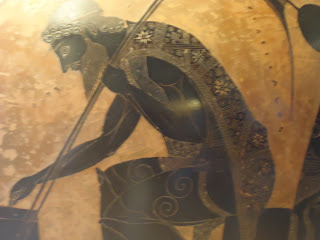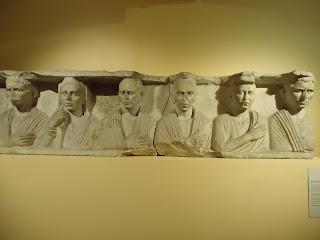At this point, anyone who reads about things classical on the internet knows of the dust up over the BBC video on Roman Britain and its inclusion of a Roman soldier of African origin. If you need a quick refresher, you can check out a short article at Indy 100 (from the Independent) and another at The Atlantic. Then you can appraise yourself of the subsequent internet abuse heaped on historian Mary Beard when she involved herself in the discussion. This brawl over diversity in the classical world is one of a series that have occurred in recent months and echoes those surrounding Sarah Bond's article on painted marble in antiquity and the white supremacist motives for removing the paint and Donna Zuckerberg's call for a consciously more inclusive approach to Classics--the comments in both articles are amazing demonstrations of ignorance and virulence on one side and exasperation and resignation on the other.
 |
| Janiform of African from Syracuse, Sicily. |
These controversies in Classics mirror a broader questioning of the value of diversity in the US and British populations that have manifested in recent political elections and policy proposals--from Brexit to the Trump administrations proposals to restrict travel, build a wall on the US-Mexico border, and change the way visas are granted to work in the US. The rhetoric of inclusion has even been changed in the way the US government discusses citizenship--no longer is their a grant to help with "Citizenship and Integration", but "Citizenship and Assimilation" and the Department of Justice is looking to investigate Affirmative Action in colleges as if they believe that too many non-whites are getting into US colleges.
The dynamics at play in the broader political world and Classics seem, in some ways to be related as it is not professional classicists who are up in arms about discussions about the diversity of the ancient Mediterranean--we have all sorts of archaeological, literary, and, increasingly, genetic evidence to show this was the case. Those who are upset by the "un-whitening" of the ancient world are casual, non-professional consumers of the ancient world and, in some cases, scholars in other fields who have no professional expertise and no more knowledge than the average college student or who want to privilege unreliable evidence (like genetics) over all other types of evidence. What these individuals have in common, however, is a shared world view in which the ancient Greek and Roman worlds are filled with white people and that they, therefore, belong to white people--and underlying this assumption is another assumption that the ancients knew what whiteness was and considered themselves a part of it.
I have written elsewhere on how the field of Classics can be complicit in the construction of this narrative by playing up the "foundations of western civilization" angle and downplaying the racism and misogyny in some of our ancient sources--an approach that lends credence to white supremacy groups. People seem less bothered by the notion that the ancient Athenians were racist. In fact, that is one of the appeals. Some people get very upset, however, when scholars point out the variety of ways they weren't racist and were, instead, open to diversity.
 |
| Clay figures of African characters from the theater in ancient Syracuse, Sicily. |
What these people often have in common is a flexible understanding of whiteness that sometimes includes people of Near/Middle Eastern descent and sometimes doesn't. If they want to prove that there were no black Africans, they emphasize that north Africa in antiquity was "white"--according to the US census, Near/Middle Eastern counts as white, not "of color". This makes it convenient to assume the cultural achievements of ancient Egypt, Persian, the Phoenicians and their colonies, etc for "whiteness". However, when one speaks of ancient and medieval Islam, all the sudden, those same people are no longer "white". Why? Arab peoples are considered white in the US census, but non-white when religion is mentioned. So, in modern terms, racially, they are white, but culturally "other"--if one assumes that the US is a "Christian nation", which is debatable; the Founding Fathers intentionally left religion out of the picture, but it is a majority Christian population. This makes one wonder how the ancient Greeks and Romans--definitively non-Christians--can get to be the foundation of a civilization that seems to hold Christianity as a key identifier and how they get to be "white" in this particular sense. It also makes one wonder why so many people are so invested in a white Greco-Roman antiquity.
A further commonality of many of the individuals who are unsettled or even angry at the notion of a multiethnic/multiracial Classical world is that they will typically try to argue that the un-whitening of antiquity is political correctness run amok or the imposition of modern ways of thinking on the ancient world--as if the ancients had no concepts of race/ethnicity. When you hear the argument that talking about the diversity of the ancient world is some sort of liberal political correctness, you can fairly easily gauge the ideological position of the person--that language is straight out of the Karl Rove and now Pres. Trump playbook for dismissing academic expertise and for undermining any study or discussion that might counter a narrative that white, western civilization is ancient in its foundations and superior to any others.
And, this, at last, gets us to the question posed in the title of this post--why do some people get so upset when we talk about how diverse the ancient Greek and Roman societies were? Because if Classical antiquity is the foundation of western civilization and they were multiracial/multiethnic societies, then the idea that western civilization is a white accomplishment based on a history of white superiority is called into question. And if you truly believe that your own identity is bound to being white and to this historical narrative of whiteness, then finding diversity and inclusion at the roots of western culture means that maybe your whiteness fetish is problematic and the drive by those who embrace it to exclude other religions, traditions, skin tones, etc. from our society is most likely good old fashioned modern racism and not inherent in our destiny after all.
















































